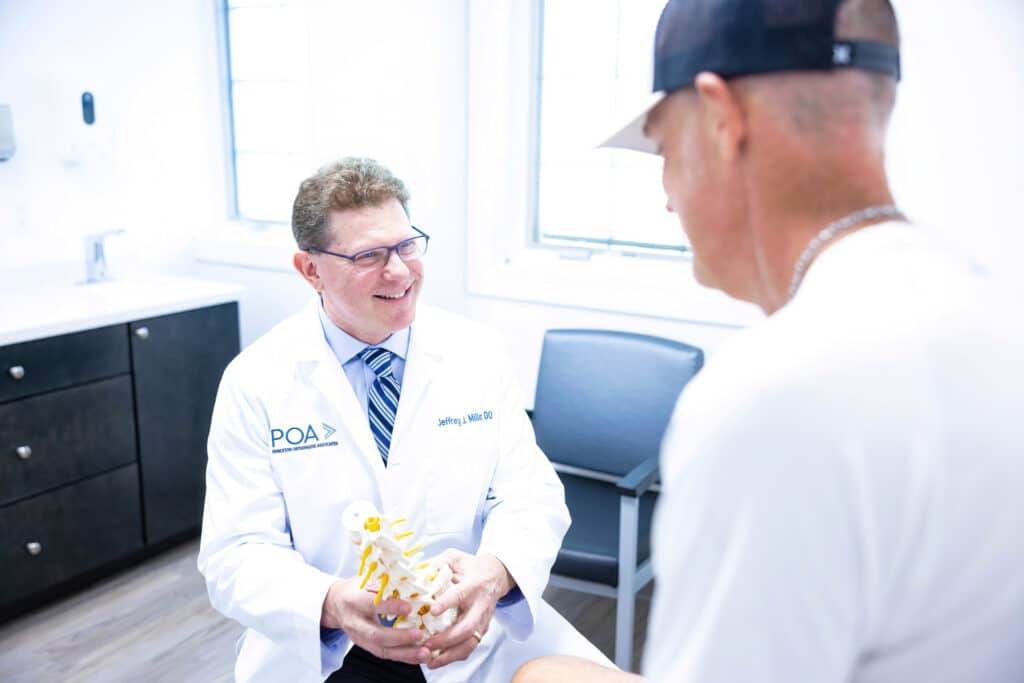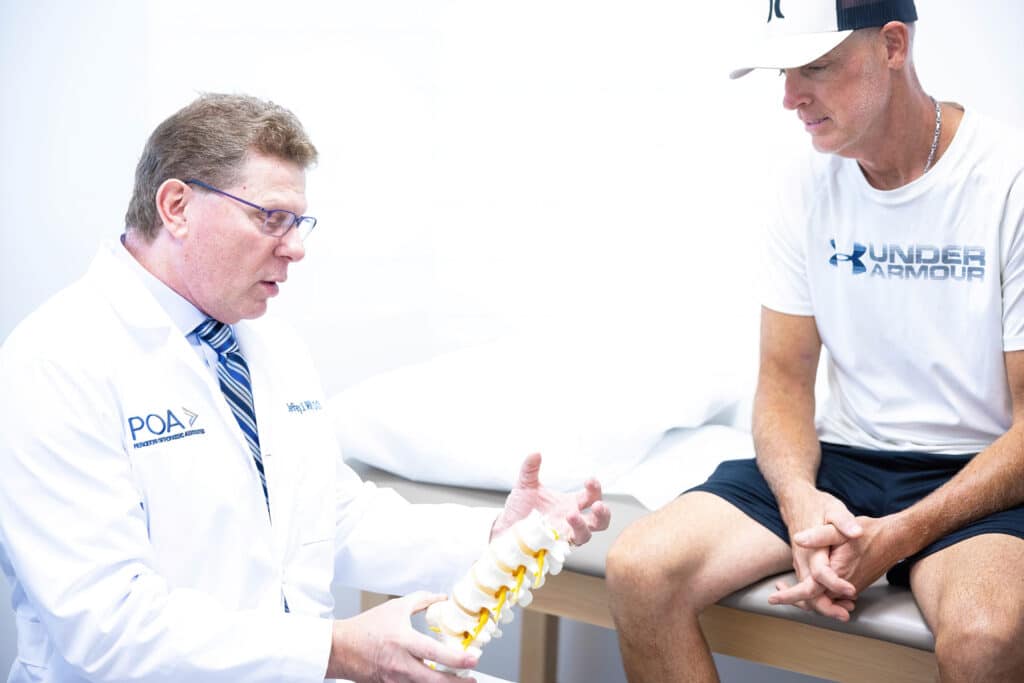
Physician Assistants
Physical & Occupational Therapists
KneeMRI ScansNon-OperativePhysiatry
Physical Therapy
Podiatry
Spine
Sports Medicine
TraumaUrgent Care
X-Ray Imaging

Sciatic pain can be a debilitating issue, especially for those who lead an active lifestyle. Whether you're an avid hiker or enjoy weekend outings of biking, the back and leg discomfort associated with sciatica can put a serious damper on how much activity you can handle. Thankfully, there are steps that you—the active person experiencing sciatic pain—can take to both treat and prevent this particular kind of discomfort. As an orthopedic specialty group, we believe it is important that everyone takes their health into their own hands when possible by understanding what their body requires in order to stay healthy and strong. That's why were happy to share the stretches and exercises necessary to help alleviate your sciatic pain while strengthening your back so that you'll be prepared for years of future activities

Sciatic pain, often referred to as sciatica, is a prevalent and sometimes debilitating condition that originates from the sciatic nerve – the largest and longest nerve in the human body. This nerve extends from the lower back, through the hips and buttocks, and branches down each leg, controlling much of the sensation we experience in these areas. When the sciatic nerve becomes irritated or compressed, it can result in a range of symptoms such as severe lower back pain, sharp shooting pain, tingling, numbness, or weakness in the legs, hips, or buttocks. The primary cause of sciatica is often attributed to a herniated or slipped disc, which can exert pressure on the nerve. Other common causes may include conditions like spinal stenosis, piriformis syndrome, and spondylolisthesis. In addition to these, factors such as obesity, prolonged sitting, and improper lifting techniques can further exacerbate the risk of developing sciatic pain.

The alleviation of sciatic pain is a widely-discussed subject, and one of the most effective methods to address this issue is through stretching. Stretching benefits individuals suffering from sciatic pain by gently releasing tension in the muscles surrounding the sciatic nerve, thus easing the pressure and allowing a better range of motion. Incorporating a regular stretching routine not only targets the root cause of pain, but it also promotes overall flexibility, reducing the risk of further aggravated sciatic episodes. It is important to note that performing stretches specific to the lower back and gluteal muscles is crucial in facilitating this relief process. Consequently, seeking guidance from a healthcare professional or a certified therapist ensures that the appropriate stretching techniques are employed to achieve optimal relief for sciatic pain.

Lower back muscles play a crucial role in maintaining the stability and flexibility of the spine, making it essential to include exercises aimed at strengthening this area in our fitness routine. With an increased rate of sedentary lifestyles and poor posture habits, a significant number of people report lower back pain and discomfort, which can affect daily activities and overall well-being. By incorporating targeted exercises such as lumbar extension, pelvic tilt, cat-cow stretch, and deadlifts, individuals can effectively build muscle strength, enhance range of motion, and alleviate discomfort. Furthermore, practicing core-strengthening activities like Pilates and yoga can complement these exercises by bolstering the muscles that support the lower back, ultimately leading to better posture, pain reduction, and improved quality of life. To maximize results, it is crucial to adopt a consistent approach, maintain proper form, and consult a healthcare or fitness professional for individualized guidance.
Dealing with sciatica pain can be a challenging task for many individuals, as it tends to have a significant impact on their daily life activities. However, incorporating certain stretches in your fitness routine can help alleviate this discomfort to a large extent. It is crucial to focus on stretches that specifically target the lower back, glutes, and hamstrings, as these areas play a major role in sciatic nerve function. Some key stretching exercises include the knee-to-chest stretch, the pigeon pose, and the seated spinal twist. Engaging in these targeted stretches consistently can not only provide immediate relief, but can also help in the long term by promoting flexibility and maintaining spinal health. Remember to consult with a medical professional or a physiotherapist before starting any new exercise routine to ensure that it's tailored to your specific needs and is safe for your condition.
Experiencing recurrent sciatic pain can significantly disrupt an individual's daily routine, affecting their overall quality of life. Consequently, it is crucial to be proactive in implementing strategies to help reduce the risk of enduring this distress in the future. One effective approach is to engage in regular exercise, focused primarily on stretching and strengthening muscles in the lower back, hips, and core. This can improve posture and provide essential support to the lumbar spine, which often contributes to sciatic pain. Another critical factor to consider is maintaining a healthy body weight, as excessive weight can place unnecessary pressure on the sciatic nerve. In addition, practicing good ergonomic habits, such as using chairs that promote proper alignment, can make a substantial difference in avoiding sciatic discomfort. Lastly, consulting with a medical professional to identify the root cause of one's sciatic pain is imperative in order to establish a tailored prevention and management plan that effectively addresses the individual's unique needs.
Dealing with persistent pain can be incredibly daunting but knowing when to seek help from an orthopedic specialist can be a game-changer for effective pain management. Recognizing persistent pain that doesn't respond to conventional methods is essential; it could be a sign of a deeper problem that warrants professional intervention. An orthopedic specialist offers a cache of knowledge and expertise in the diagnosis, treatment, and prevention of disorders related to the musculoskeletal system. When pain begins to negatively impact your daily activities, work, and overall quality of life, seeking specialized help is imperative. Do not hesitate to consult with an orthopedic specialist to determine the most suitable treatment options for your condition, empowering you to regain control of your well-being and resume the activities you enjoy.
Taking care of your body with regular stretching and exercise can be one of the best ways to prevent sciatic pain. Maintaining good posture, staying active on a daily basis, doing low-impact exercises like swimming or cycling, and using a support pillow to help with sleeping are all important tips to consider when trying to reduce this type of pain. Although sciatica is painful, it doesn’t have to be chronic or debilitating. With the right knowledge, you can develop the tools you need to reduce the amount of discomfort you experience and take back your life. When regular stretching and at-home treatments fail to make a difference in your sciatic pain symptoms, then it’s time to reach out for further help from an orthopedic specialist who can guide you through a tailored plan for alleviating your pain. We would love to help you as your specialists. Contact us today and let us help you!

© 2023 Princeton Orthopaedic Associates. The contents of princetonorthopaedic.com are licensed under a Creative Commons Attribution-NonCommercial 4.0 International License. Copying without permission is strictly forbidden.